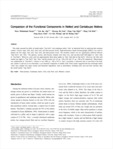

PARTNER
검증된 파트너 제휴사 자료
Comparison of the Functional Components in Netted and Cantaloupe Melons
방대한 850만건의 자료 중 주제별로 만들수 있는 최적의 산출물을 해피 캠퍼스에서 체험 하세요 전문가의 지식과 인사이트를 활용하여 쉽고 폭넓게 이해하고 적용할수 있는 기회를 놓치지 마세요
7 페이지
최초등록일 2023.07.17
최종저작일
2023.06

-
 * 본 문서는 배포용으로 복사 및 편집이 불가합니다.
* 본 문서는 배포용으로 복사 및 편집이 불가합니다.
미리보기
서지정보
· 발행기관 : 경상대학교 농업생명과학연구원
· 수록지 정보 : 농업생명과학연구 / 57권 / 3호
· 저자명 : Deen Mohammad Deepo, Yun Jae Ahn, Hyeong Jin Eom, Dong Yup Hahn, Hong Yul Kim, Eung Kyoo Choi, Un Sun Hwang, Ki Byung Lim
목차
Abstract
Introduction
Materials and Methods
1. Melon samples
2. Measurement of moisture content
3. Measurement of free sugar content
4. Measurement of folic acid content
5. Measurement of citric acid content
6. Measurement of beta-carotene content
7. Statistical analysis
Results and Discussion
1. Water content
2. Free sugar content
3. Folic acid content
4. Citric acid content
5. Beta-carotene content
Acknowledgments
References영어초록
This study assessed the utility of netted melon ‘Top Earl’s’ and cantaloupe melon ‘Alex’ as functional fruits by analysing their moisture content, vitreous sugar, folic acid, citric acid, and beta-carotene levels. High-performance liquid chromatography (HPLC) was used to analyse the free sugar, folic acid, citric acid, and beta-carotene levels. The moisture content was not significantly different between ‘Top Earl’s’ and ‘Alex.’ The glucose, sucrose, and fructose contents were three, two, and one-and-a-half fold higher in ‘Alex’ than in ‘Top Earl’s.’ Moreover, citric acid was approximately three times higher in ‘Alex’ than that in Top Earl’s.’ However, the folic acid content was higher in ‘Top ‘Earl’s’ than ‘Alex,’ and the amount was 124 μg / 100 g FW and 112 μg / 100 g FW respectively. ‘Beta-carotene was undetectable in ‘Top Earl’s,’ whereas it was 1000 μg / 100 g FW in ‘Alex.’ β-carotene, a substance that is converted in the body into vitamin A and acts as an antioxidant, is an important component in healthy food. These results suggested that the cantaloupe melon ‘Alex’ has a higher free sugar content and functional ingredients, such as antioxidants, including citric acid and beta carotene, than the netted melon ‘Top Earl’s.’참고자료
· 없음태그
-
자료후기
-
자주묻는질문의 답변을 확인해 주세요

꼭 알아주세요
-
본 학술논문은 (주)코리아스칼라와 각 학회간에 저작권계약이 체결된 것으로 AgentSoft가 제공 하고 있습니다.
본 저작물을 불법적으로 이용시는 법적인 제재가 가해질 수 있습니다. -
해피캠퍼스는 구매자와 판매자 모두가 만족하는 서비스가 되도록 노력하고 있으며, 아래의 4가지 자료환불 조건을 꼭 확인해주시기 바랍니다.
파일오류 중복자료 저작권 없음 설명과 실제 내용 불일치 파일의 다운로드가 제대로 되지 않거나 파일형식에 맞는 프로그램으로 정상 작동하지 않는 경우 다른 자료와 70% 이상 내용이 일치하는 경우 (중복임을 확인할 수 있는 근거 필요함) 인터넷의 다른 사이트, 연구기관, 학교, 서적 등의 자료를 도용한 경우 자료의 설명과 실제 자료의 내용이 일치하지 않는 경우
“농업생명과학연구”의 다른 논문도 확인해 보세요!
-
국내 과수작물 재배시 사용되는 비료의 종류 및 사용량 평가 6 페이지
우리나라는 무기질비료 사용량이 많은 나라 중 하나이다. 그러나 1980년 이후 지속가능농업에 대한 필요성에 의해 1997년 친환경 농업육성법이 제정되었고 지속가능한 농업을 위한 연구로 논, 밭, 시설 및 과수에 대한 비료사용실태조사가 실시되고 있다. 이에 본 연구는 과수 중 대표되는 7작물(배, 포도, 사과, 복숭아, 대추, 단감, 키위)을 대상으로 각 도.. -
고온 환경에서 사료내 트립토판과 나이아신의 단독 혹은 혼합 첨가가 산란계의 생산성, 난품질, 지방간 지표 및 혈액성상에 미치는.. 11 페이지
본 연구는 고온 환경에서 사료내 트립토판과 나이아신의 첨가가 산란계의 생산성, 난품질, 지방간 지표 및 혈액성상에 미치는 상호작용 효과를 조사하고자 수행되었다. 총 384수의 25주령 로만 갈색종 산란계를 4처리 8반복으로 반복당 12수씩 무작위 임의 배치하였다. 기본 사료는 트립토판과 나이아신의 추가적인 첨가는 없으며 모든 영양소 및 에너지는 로만갈색종 .. -
체외 소화과정 동안 Gastric lipase의 첨가가 반려견 사료의 소화율에 미치는 영향 6 페이지
본 연구는 위장 단계의 소화과정에 관여하는 Gastric lipase (GL)를 반려견을 위한 정적 체외 소화모델(Static in vitro digestion model)에 적용을 검토하기 위하여 실시되었다. GL의 첨가가 체외 소화과정 동안 건물(Dry matter; DM), 조단백질(Crude protein; CP) 그리고 조지방(Ether extra.. -
Effects on the Productivity and Blood Characteristics of Broilers Fed .. 7 페이지
-
Effects of Dietary Vitamin C, Vitamin E, and Betaine Supplementations .. 11 페이지
문서 초안을 생성해주는 EasyAI
